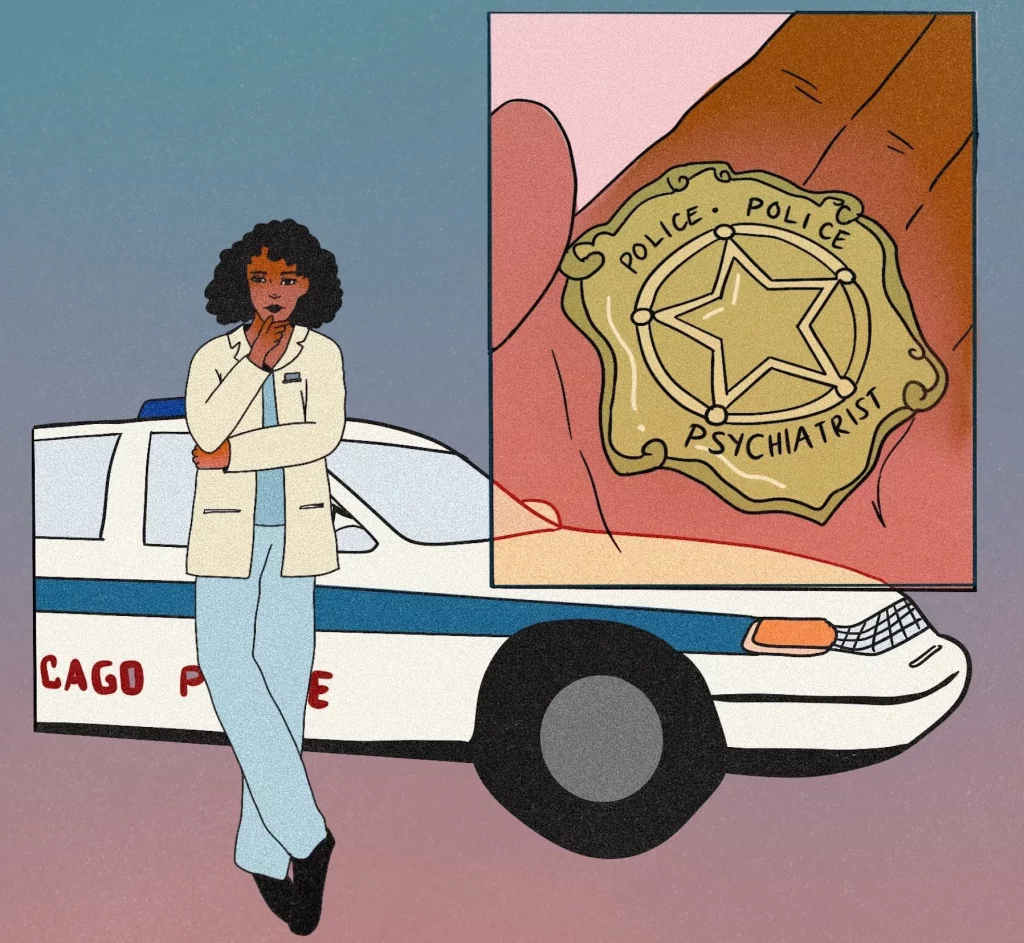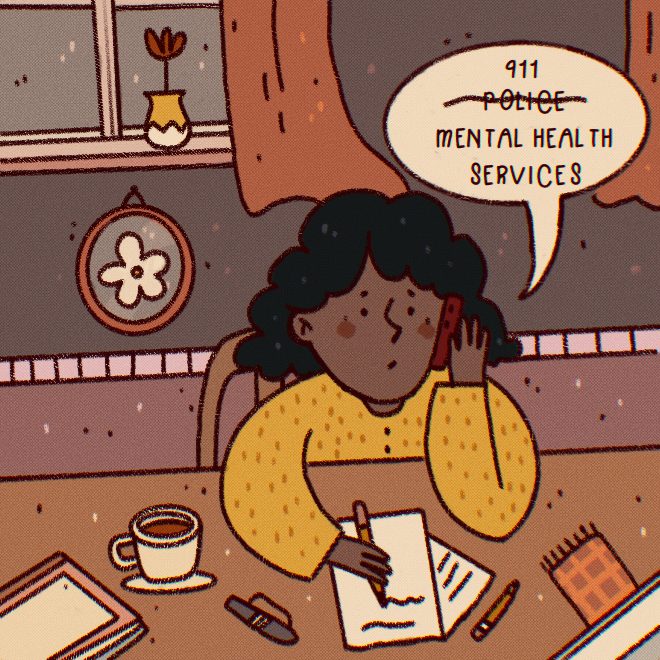In this November’s midterm, Chicagoans in three wards encompassing neighborhoods from Auburn Gresham to Albany Park voted overwhelmingly in support of a referendum asking if the city should reopen its closed public mental health centers in support of a crisis response system that would not involve police. The decisive public mandate was years in the making.
I remember being home for the holiday break from my senior year of college and sitting at my mom’s kitchen table when we read the news about Quintonio LeGrier and Bettie Jones in December 2015. Quintonio was a nineteen-year-old college student, not much younger than I was at the time, also home from college for the holiday break. The morning after Christmas, Quintonio called 911 for help three times. He pleaded with the operator to send the police before being dismissed and ultimately hung up on. Then his father called explaining that his son had “freaked out” and was holding a baseball bat. As the LeGrier family navigated what to do, Quintonio experienced an intensifying mental health crisis.
The family tried to seek help, but was eventually met by police officers who arrived at their door with guns drawn. Neighbor, community activist, and mother Bettie Jones opened the door for officers, presumably with the intent of preventing a police interaction from escalating. Within minutes, CPD officer Robert Rialmo shot Jones once and LeGrier six times, killing both of them. Police documents later acknowledged that proper medical care to try to revive them was not delivered after either victim had been shot.
What the LeGrier family reached out for was support finding care and someone to help de-escalate their son’s mental health crisis. What officers delivered was a violent response resulting in two tragic losses.
LeGrier’s story is unfortunately not rare. Policing and other approaches to mental health that meet people in need of care with force or punishment often have incredibly harmful consequences and exacerbate problems. In addition to the alarming rates at which police kill people with mental illness, law enforcement interactions with those in crisis commonly result in a person being injured, incarcerated, or enduring further psychological distress.
This year, hundreds of volunteers signed up to knock on doors, make phone calls, translate campaign materials, help with data entry, distribute yard signs, and more. Going door-to-door on the hottest days of August and the coldest of October, we heard from longtime residents who remembered the closed mental health centers in their neighborhood, who knew people who relied on them, who remembered when community fought their closure, and who still believe we deserve mental health centers that are public and accessible to all. We heard from people with a range of experiences how deeply felt the reality of not having someone to call or a place to go in a moment or time of crisis really is.
One Back of the Yards family spoke about calling 911 for help getting care for a loved one who was having a mental health episode during a gap in access to needed medical care for both their diabetes and mental health. They were then arrested and ended up spending a year in Cook County Jail instead of receiving the medical attention they were looking for.
On election night, surrounded by a few dozen volunteers tired from a long day of talking to voters, we started refreshing the Board of Elections website as soon as the polls closed. We had spent the better part of the last six months having thousands of variations of the same conversation that built on over a decade of organizing to reopen the mental health centers and a parallel decade of organizing around the city’s bloated police budget: Would you like to see the City invest more in mental health? Do you support mental health workers instead of police officers responding to mental health crises? Have you lived in the neighborhood long enough to remember the clinic on Woodlawn? Would you like to see the city to reopen the mental health centers they closed down?
The referendum results finally came in at more than ninety percent favoring Treatment Not Trauma (TNT), a model for public mental health infrastructure that would include city-run mental health centers and a 24-hour crisis response hotline that would dispatch mental health workers instead of police officers. A concrete proposal by, for, and supported by community, Treatment Not Trauma was envisioned by a coalition of people with mental illnesses, care workers, researchers, and community members with the Collaborative for Community Wellness (CCW), and was introduced to city council by Alderwoman Rossanna Rodriguez-Sanchez in 2020.
There are over two million arrests of people with mental illnesses each year in the U.S. In almost every state, jails or prisons claim to treat more people struggling with mental illness than hospitals do. In the current landscape, there are far too many ways people in need end up criminalized and further traumatized and never accessing quality care.
Chicago’s current void of public mental health infrastructure should be understood in the context of how neoliberal reform has manifested locally. Cutting funding for or privatizing public programs and institutions like clinics or schools is part of how political leaders pull the rug out from under working class communities and leave us all more vulnerable to crisis. Steadily increasing funding for police while just about everything else is on the chopping block contributes to the reality that policing and criminal punishment are the default responses to social problems that might better be handled with care or a preventative approach that gets at root causes.
The powerful display of public opinion reflected by the referendum results came ten years after former mayor Rahm Emanuel shut down half the city’s remaining mental health clinics in a supposed move to save a mere $3 million. In the mid-1990s, there were nineteen city-run mental health clinics. By 2012, there were twelve.
Today there are only five.
Analyzing behavioral-health related 911 calls by ward and neighborhood, CCW published a report this year that shows that some of the highest concentrations of mental health crisis calls are in the parts of the city where clinics were shut down. These tend to be Black and Brown neighborhoods impacted by other forms of ongoing divestment that have a negative impact on the mental health, stability, and overall well being of communities. What CCW’s research highlights is that one impact of the closure and absence of mental health facilities is that more escalated crises arise where they could have been avoided if there were access to consistent care and other forms of support. CCW’s report reads, “[w]ith the decimation of the public safety net . . .mental health needs often go unaddressed until they reach a point of crisis.”

The campaign for Treatment Not Trauma is as much about crisis response as it is about being part of a robust network of public institutions, systems, and programs Chicagoans could rely on for care in order to prevent as many crises from occurring. It’s a vision for creating mental health centers that could play an even larger role than the clinics that once existed.
Public mental health infrastructure in Chicago, as outlined by TNT advocates, would include mental health centers that offer more holistic forms of care that certainly don’t involve police or incarceration, but also that don’t overly rely on medication or hospitalization. It would provide accessible therapy and support finding housing and getting other needs met. It would offer peer support teams and resources for loved ones to be supported in playing a role in caring for the people in their lives who need it. It would be trauma-informed and not one-size-fits-all.
Building on Emanuel’s legacy, Mayor Lori Lightfoot has doubled down on an approach to mental health that relies on private providers and police involvement while failing to invest in public institutions. When she ran for office, Lightfoot promised to reopen the clinics “and more”—but quickly backtracked. Private clinics, which are the basis of Lightfoot’s insufficient approach, have simply been unable to meet the scale of need that exists in the way a public system could. That’s not to mention how private facilities tend to underpay and under-resource providers who are then left without what they need to offer quality care.
Chicago communities most impacted by the compounding crises of mental health, policing, divestment, and other forms of structural violence have made our voices loud and clear on this issue for years. When Mayor Richard M. Daley first tried to shut down some of the city’s mental health clinics, community forces came together in protest and were able to effectively stop him. During Emanuel’s time, a movement made up of patients, mental health providers, and community members fought hard to keep clinics open. They persistently and powerfully organized community forums, confronted the mayor at his house, engaged in civil disobedience, and other forms of protest.
Now, a movement of Chicagoans has again shown that we are backed by the opinions of thousands in calling for Treatment Not Trauma. In the 20th Ward, where community members actually occupied and camped outside of the Woodlawn Mental Health Clinic for a whole summer before its ultimate closure in 2012, this year’s referendum passed by ninety-six percent.
The South Side’s 6th Ward includes precincts that have the highest concentration of mental health crisis calls to 911 in the whole city. Sixth Ward alderperson, Roderick Sawyer, who chairs the Health and Human Relations Committee, has failed to schedule a committee hearing on Rodriguez-Sanchez’s Treatment Not Trauma ordinance since she introduced it in 2020. (Sawyer did schedule a hearing in March 2021 on the City’s existing CARE pilot program, which sends mental health professionals alongside police, but not on the TNT ordinance itself.) Residents of the 6th Ward voted in favor of the referendum by ninety-eight percent.
And in the 33rd Ward on the city’s northwest side, home of TNT champion Rodriguez-Sanchez, it passed with ninety-two percent support.
Our communities have voiced a clear desire for a solution that is both incredibly commonsense and wholly different from what we have now. With consensus from communities across the city, Chicago political leaders and hopefuls should take action by getting behind funding and implementing Treatment Not Trauma. And we should see that as one important element of a broader set of needed investments and policies that take responsibility for making and keeping the city truly livable for its Black, Brown and working-class residents.
This story was first published by the Chicago Reader on November 18. Republished with permission.
Asha Ransby-Sporn is a community organizer who served as the field director on the Treatment Not Trauma referendum effort in the 20th Ward.

